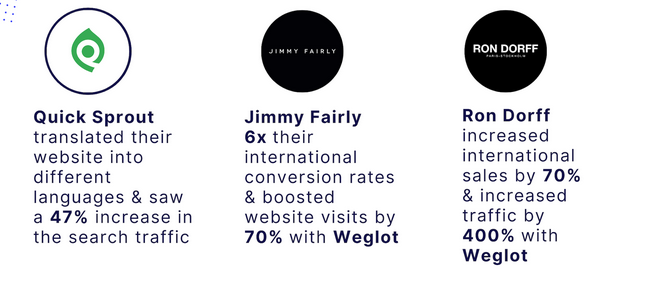If you have a business, then I will tell you What is Website Localization? And why is it important, so if you want to know about it, then keep reading this article? Because I am going to give you complete information about it, so let’s start.
Did you know that 73% of customers prefer purchasing products from sites providing information in their native language?
Website localization becomes a crucial aspect when you plan on going global. While English is understandable in most parts of the world, people connect better with their regional language.
But is website localization limited to translation? It’s one of the biggest myths revolving around the process as it covers much more than language. The entire motive is customizing your website to make it familiar to your target audience.

This article will eliminate the myths associated with the process and cover various aspects that lead to calculating growth. Let’s begin by understanding the meaning and importance of website localization.
Table of Contents
What Is Website Localization?
Let’s say your business is planning to go global. Your website requires content that anyone can understand to implement the tactics that obtain results successfully.
Website localization involves checking the website code supporting alphabets in different languages, modifying the payment option to cater to the specific currency used, ensuring the website stands up to the target audiences’ cultural values, etc.
You can hardly build connections with your target audience if your process solely revolves around translation. Considering important cultural aspects must be prioritized. For instance, there might be offending cultural references or phrases that don’t translate well. Analyzing crucial aspects ensures you achieve the expected results in such a scenario.
Furthermore, websites must take care of mages, videos, voiceovers, etc. Taking these things into account shows your audience you have gone the extra mile to make the content suitable.
What Is Website Localization Testing & Why It Is Important?
As discussed earlier, localization focuses on catering to audiences in different countries or specific regions. Localization testing refers to checking whether the website is fully functional in the targeted areas. Various factors like language, cultural preferences, area regulations, interface, and more are considered.
Businesses often use a residential proxy to select a specific region and obtain data without security concerns. However, the focus remains intact on customizing the website based on the particular preferences of the target audience.
Let’s now take a brief look at why implementing website localization testing is essential:
- Website localization focuses on building lasting connections with the audience that doesn’t speak the same language as you. Errors, bugs, and typos are the least preferred choices to achieve the same.
- Understanding your target audience and updating your website accordingly provides an excellent user experience. Little efforts, including using a culturally specific color scheme, bring a huge difference to engagement.
- Succeeding in a global business requires an in-depth understanding of the specific regions rather than general translation.
- Implementing localization early in the development process saves you from the extra expenses required in modifying codes at later stages.
- Investment in the needs or preferences of your target audience reaps results through valuable international opportunities.
- Making a mark on the global market requires a deep understanding of your region-specific target audience.
- Identifying and eliminating bugs in earlier stages will save you from losing potential customers.
How To Successfully Perform Website Localization?
Let’s now move further with the core steps involved in testing website localization:
1. Create A Localization Strategy Aligning With Your Brand
Here are the essential things consisting in a successful localization strategy:
- It consists of a list of targeted countries or regions, specified content/messaging, and market research aligning with the brand’s vision and values.
- One core factor of the strategy is the bases used to measure the overall success.
- Dedicate sufficient time to conducting market research to understand your target audience’s languages, social values, preferences, etc.
- Spend ample time on appropriate presentation as presentation is vital apart from translation.
- Select the team members responsible for performing specific localization tasks, including translation, designing, development, etc.
- Set key performance indicators to measure the success of your strategy.
Take a look at the results derived by some of the top companies after implementing an appropriate localization strategy.

2. Implement Internationalization In Your Website
Internationalization becomes a key factor when you gradually increase your reach worldwide. The implementation is a one-time process undertaken during the design and development process.
Translation becomes much more manageable at every given point without drastic engineering changes. Apart from translation, it considers other core aspects, including time zones, text formatting, etc.
Note that this becomes an extra step only when you don’t have access to CMS like WordPress. These technological advancements make the entire process easier. The plugins available help the users quickly set up and operate a multilingual website catering to audiences’ needs all over the globe.
Out of all the available CMS options, WordPress is the most preferred option. WPML (WordPress Multilingual) Plugin can be easily integrated and makes the process smoother with minor tech assistance required. This becomes another reason to invest in a sound content management system to cater to the specific needs of your international audience.
3. Choose & Implement Agile Localization
Agile localization focuses on automatic translation with every big or small update. Implementing this methodology is crucial due to the never-ending requirement for translation with every development. Your website is continuously updated with the changes, and your target audience doesn’t suffer unnecessary glitches. The right CMS will help you choose a suitable workflow that aligns with your needs.
Lastly, many businesses go for a website translation proxy that helps present the right content based on the user locale.
4. Keep Testing Your Current Strategy
Work on timely testing after creating a successful localization strategy aligning with your brand. This involves testing particular market regions, checking linguistic errors, color schemes, etc. Many tools automate the entire process, giving your team more time for operating other tasks.
Set key performance indicators that help you major the success of your strategy. The KPIs include translation cost, market share, conversion rates, sales in different locations, social media engagement, and more.
Monitoring your competitors becomes another core area of focus to modify your current strategy. Go for web scraping to obtain your competitors’ information using residential proxies that support mass scraping by allowing you to rotate the IPs continuously.
5. Selecting The Right Software For Localization
Localization becomes difficult when your company operates on varied digital platforms. Here are some tools you need for the perfect alignment that reaps results:
- A translation management software tackling the localization workflow
- Installation of necessary plugins in your current CMS for smooth functioning
- A translation memory and glossary saving previous translations for future references
- Quality assurance tools that cater to specific requirements like grammatical accuracy
- A continuous localization platform for successfully integrating localization into your process.
Conclusion:)
- Website localization is a core step when a business plan to enter the global market.
- Localization focuses on making a website suitable for an international audience by catering to their language and cultural norms.
- Website localization testing identifies and eliminates bugs and errors arriving after localization.
- Localization testing involves three significant steps- linguistic testing, cosmetic testing, and functional testing.
- It’s crucial to create a localization strategy aligning with your brand. The process involves targeting specific regions, selecting KPIs, delegating tasks to team members, focusing equally on translation and presentation, etc.
- Implementing internationalization during the design and development process allows smooth translation without drastic technical changes.
- Go for continuous localization for a better response from your global audience.
- Choose the right software and keep testing website localization to fix errors or bugs.
Read also:)
- 5+ Key Steps To Creating a Small Business Website: A-to-Z Guide!
- What is Web Designing: A-to-Z Guide for Beginners!
- Top 10 Website Builders in India: A-to-Z Guide for Beginners!
So we hope that this article of ours What is Website Localization? And why is it important. Or if you still have any questions and suggestions related to this, then you can tell us in the comment box below. And thank you very much for reading this article.